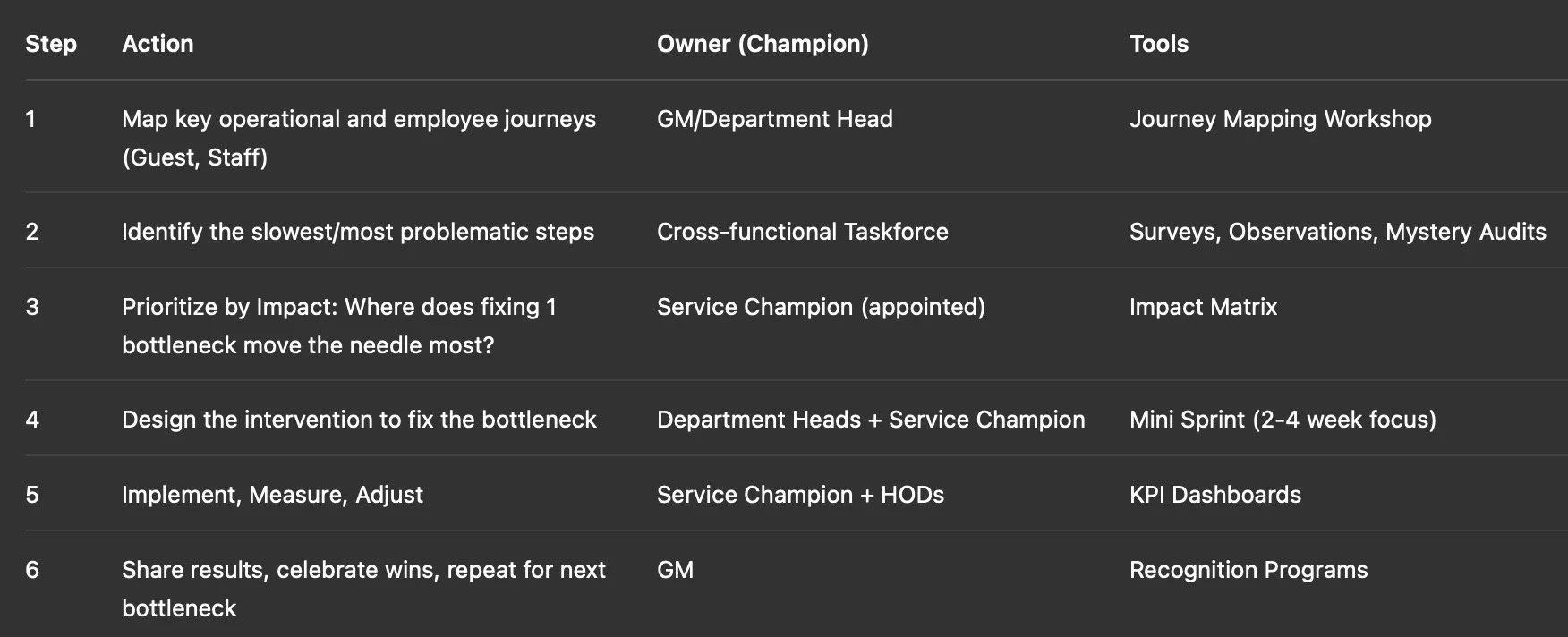The Bottleneck You Don’t See: Using Amdahl’s Law to Unlock Hotel Efficiency
Amdahl’s Law reminds us that no matter how much you optimize parts of a system, the overall speed is limited by the slowest part.
In hospitality, it’s easy to fix the obvious, but the real gains come from uncovering hidden bottlenecks.
Your guest experience is only as fast and as smooth as your slowest process.
✨ Why It’s Relevant to Hospitality & Service Industries
Hotels, resorts, and service businesses are complex ecosystems. Guests don’t experience departments, they experience the whole journey.
A single delay, housekeeping, engineering, onboarding, can drag down the perception of the entire brand.
✨ More Detail on the Topic
In computing, Amdahl’s Law quantifies how system performance improves or fails to depending on the slowest element.
Even a 90% improvement elsewhere won’t matter if the remaining 10% is sluggish.
In hotels, it’s often not the obvious things (like check-in speed or restaurant menu variety), it’s the hidden, backstage operations that silently define success or failure. Smart leaders don’t just polish what’s already good. They hunt for and fix the real constraint.
✨ Actionable Insights
Walk the guest journey yourself. Don’t rely on reports.
Identify the slowest link: Is it room readiness? Engineering response? Training gaps?
Fix that first.
Speed everywhere else will multiply only after the bottleneck is cleared.
“Focus beats frenzy. Solve the one thing that holds back everything.”
✨ Real World Example
At a luxury beach resort in Goa:
Digital check-ins were flawless.
AI-driven upsells were working.
But guests were frustrated waiting for rooms.
The real issue? Housekeeping delays caused by laundry vendor backlogs.
Only after moving to in-house laundry for essentials and syncing the housekeeping roster with arrival peaks did satisfaction scores rise and occupancy profitability improve.
Another example?
A hotel chain hired aggressively post-pandemic but struggled with staff performance. It wasn’t the people, it was the lack of structured onboarding. After building a simple 30-day onboarding plan, time-to-peak-productivity dropped by 40%, and early attrition rates fell dramatically.
✨ Want to Make This WOW?
Look beyond “what can we improve” and ask, “What must we fix first?”
Bottlenecks are often hiding where you least expect:
Linen logistics
Engineering escalation processes
Banquet kitchen prep
Induction and onboarding clarity
Guest complaint handover loops
Tackle the true constraint. Everything else lifts.
✨ Something You Should Do Right Now
At your next HOD meeting, ask each department:
“What’s the one bottleneck slowing your team down the most?”
Collect the answers, no blame, no defense, just facts.
You’ll spot your biggest hidden opportunity almost immediately.
What does this look like when applied to Employee Experience (EX)?
▶ The Core Shift: Instead of just focusing on fixing “guest experience bottlenecks,” you ask:
“Where is the employee experience bottleneck that’s slowing down engagement, retention, and performance?”
Employee Bottlenecks could be:
Onboarding: New joiners feel lost and unsupported → low early productivity.
Training Access: Skills gaps not addressed fast enough → frustration builds.
Internal Transfers: Career moves inside the company are too slow or opaque → talent leaves.
Recognition: No quick wins or feedback → morale bottlenecks.
Manager Support: Line managers overwhelmed → coaching bottlenecks.
How it would work:
Map the employee lifecycle (Joining → Learning → Growing → Leading).
Identify the slowest step — where most frustrations accumulate.
Fix that first.
✅ Example Action:
Create a 30-day New Joiner Accelerator Program — buddy systems, fast-track learning, early feedback, first win celebrations.
✅ EX Insight Summary:
“If your employees stumble in their first 30 days, they rarely sprint in their first year.”
What does this look like as a Structured Process with a Champion?
✅ Champion Profile:
Mid-to-senior manager respected across departments (not necessarily the HOD).
Someone action-oriented, diplomatic, and process-driven.
Think: Guest Experience Manager, Operations Excellence Lead, or a Service Culture Champion.
✅ Insight: “Fixing bottlenecks needs ownership. Appoint a champion, not a committee.”
Please do not hesitate to reach out to discuss this for your ops.
Prabhjot Bedi | whatsapp +91 9872000604
p.bedi@eclathospitality.com



